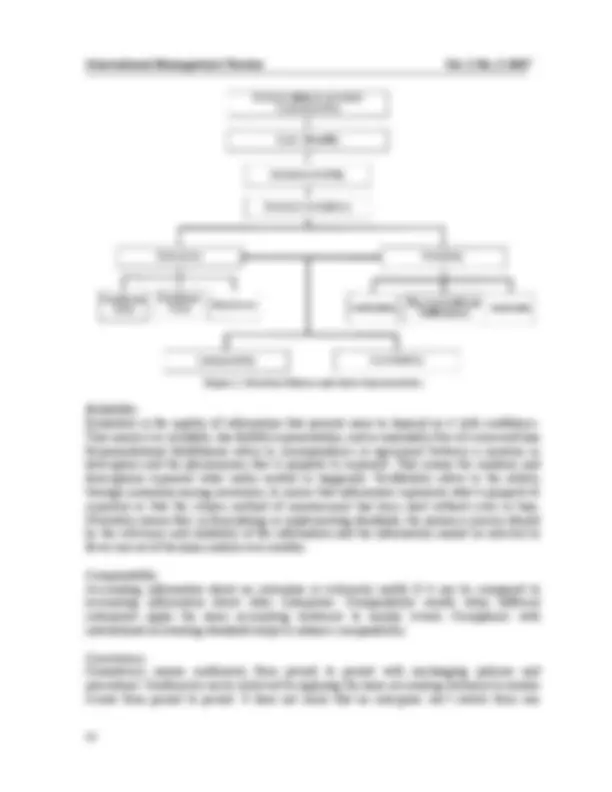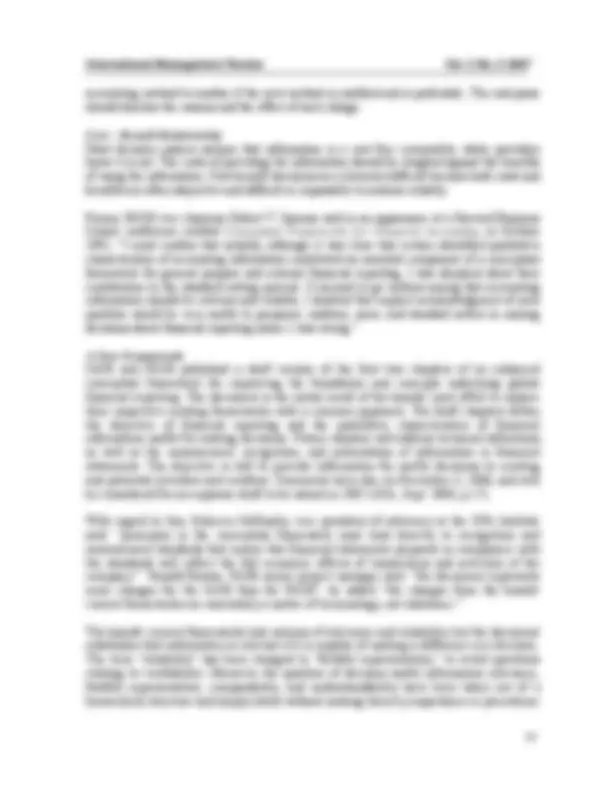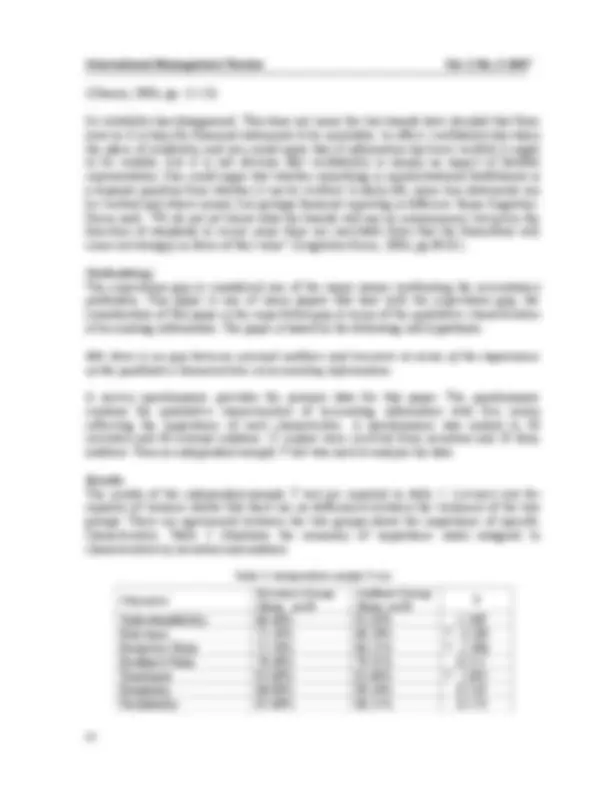





Study with the several resources on Docsity

Earn points by helping other students or get them with a premium plan


Prepare for your exams
Study with the several resources on Docsity

Earn points to download
Earn points by helping other students or get them with a premium plan
Community
Ask the community for help and clear up your study doubts
Discover the best universities in your country according to Docsity users
Free resources
Download our free guides on studying techniques, anxiety management strategies, and thesis advice from Docsity tutors
The existing gap between external auditors and investors regarding the importance of accounting information's qualitative characteristics. The study reveals that investors and auditors have different perspectives on relevance, predictive value, timeliness, reliability, neutrality, consistency, and cost-benefit. useful for university students and lifelong learners interested in accounting, financial reporting, and auditing.
Typology: Study notes
1 / 7

This page cannot be seen from the preview
Don't miss anything!




Ahmad N. Obaidat Tafila Technical University, Tafila, Jordan
[Abstract] The general objective of financial reporting is to provide useful information to present and potential investors, creditors, and others to help them make investment, credit, and other decisions. The purpose of this paper is to find out whether there is an existing gap concerning the importance of accounting information qualitative characteristics from investorsand external auditors perspective as they represent the independent part responsible for the fairness of financial reports. To achieve the purpose of this paper, a questionnaire was designed and administered to a sample of 25 investors and 29 auditors. The paper reveals that there is an existing gap between the external auditors and investors in terms of the qualitative characteristics of accounting information.
[Keywords] Accounting information; qualitative characteristics; Jordan
Introduction The principal role of financial reporting is to serve the interested parties by providing information that is useful in making business and economic decisions. Such information facilitates the efficient functioning of capital and other markets by promoting the efficient and equitable allocation of scarce resources in the economy. Each of the primary leaders of accounting standards, the International Accounting Standard Board (IASB) and Financial Accounting Standard Board (FASB), developed its conceptual framework for financial reporting, which is a coherent system of concepts that flow from an objective. The objective identifies the purpose of financial reporting. The concepts provide guidance for identifying the boundaries of financial reporting, including: selecting the transactions, other events, and circumstances to be represented; identifying how they should be recognized and measured; and identifying how they should be disclosed.
The purpose of the conceptual framework is to set forth objectives and fundamentals that will be the basis for the development of financial accounting and reporting standards. The objectives identify the goals and purposes of financial reporting. The fundamentals are the underlying concepts of financial accounting concepts that guide the selection of transactions, events, and circumstances to be accounted for, their recognition and measurement (Dahmash, 1995, p.18), and the means of summarizing and communicating them to interested parties. Concepts of that type are fundamental in the sense that other concepts flow from them and repeated reference to them will be necessary in establishing, interpreting, and applying accounting and reporting standards.
The conceptual framework consists of the following items:
The primary objective of financial reporting is to provide useful information to interested parties. This information should have qualitative characteristics to be useful for decision making.
Qualitative Characteristics The characteristics can be viewed as a hierarchy of qualities, as shown in Figure 1. Relevance and reliability are the two primary qualities that make the accounting information useful for decision making. If either is missing completely from a piece of information, the information will not be useful (Kieso, Waygandt &Warfield, 2005, p.31). Other qualities include comparability, consistency, and cost-benefit relationship.
Decision makers and Understandability Decision makers vary widely in the types of decisions they make, how they make decisions, the information they already possess or can obtain from other resources, and their ability to process the information. For information to be useful there must be a link between decision makers and the decisions they make. This link, understandability, is the quality of information that permits reasonably informed users to perceive its significance.
Relevance To be relevant to investors, creditors, and others for investment, credit, and similar decisions, accounting information must be capable of making a difference in a decision. Relevant information should have predictive value, feedback value, and timeliness. Relevant information helps decision makers make predictions about future; it has “Predictive Value”. Relevant information also helps decision makers confirm or correct prior expectations; it has “Feedback Value”. Usually, information does both at once, because knowledge about the outcome of actions already taken will generally improve decision makers’ abilities to predict the results of similar future actions. Without knowledge of the past, the basis for a prediction will usually be lacking. And without an interest in the future, knowledge of the past is useless. To be relevant, information also must be timely “Timeliness”. This means the information must be available to a decision maker before it loses its capacity to influence decisions. Information that is not available when it is needed or becomes available only long after it has value for future action is useless.
accounting method to another if the new method is justified and is preferable. The enterprise should disclose the reasons and the effect of such change.
Cost – Benefit Relationship Most decision makers assume that information is a cost free commodity, while providers know it is not. The costs of providing the information should be weighed against the benefits of using the information. Cost-benefit decisions are extremely difficult because both costs and benefits are often subjective and difficult or impossible to measure reliably.
Former FASB vice chairman Robert T. Sprouse said in an appearance at a Harvard Business School conference entitled Conceptual Frameworks for Financial Accounting in October 1982, “I must confess that initially, although it was clear that certain identified qualitative characteristics of accounting information constituted an essential component of a conceptual framework for general purpose and external financial reporting, I was skeptical about their contribution to the standard setting process. It seemed to go without saying that accounting information should be relevant and reliable; I doubted that explicit acknowledgment of such qualities would be very useful to preparers, auditors, users, and standard setters in making decisions about financial reporting issues. I was wrong.”
A New Framework IASB and FASB published a draft version of the first two chapters of an enhanced conceptual framework for improving the foundation and concepts underlying global financial reporting. The document is the initial result of the boards’ joint effort to replace their respective existing frameworks with a common approach. The draft chapters define the objective of financial reporting and the qualitative characteristics of financial information useful for making decisions. Future chapters will address technical definitions, as well as the measurement, recognition, and presentation of information in financial statements. The objective is still to provide information for useful decisions to existing and potential investors and creditors. Comments were due on November 3, 2006, and will be considered for an exposure draft to be issued in 2007 (JOA, Sept. 2006, p.17).
With regard to this, Rebecca McEnally, vice president of advocacy at the CFA Institute said: “principles in the conceptual framework must lead directly to recognition and measurement standards that ensure that financial statements prepared in compliance with the standards will reflect the full economic effects of transactions and activities of the company.” Ronald Bossio, FASB senior project manager said: “the document represents more changes for the IASB than for FASB”, he added “the changes from the boards' current frameworks are essentially a matter of terminology, not substance.”
The boards' current frameworks link notions of relevance and reliability, but the document establishes that information is relevant if it is capable of making a difference in a decision. The term "reliability" has been changed to "faithful representation," to avoid questions relating to verifiability. Moreover the qualities of decision-useful information relevance, faithful representation, comparability, and understandability have been taken out of a hierarchical structure and simply listed without ranking them by importance or precedence
(Cheney, 2006, pp. 12-13).
So reliability has disappeared. This does not mean the two boards have decided that from now on it is okay for financial statements to be unreliable. In effect, verifiability has taken the place of reliability, and you could argue that if information has been verified it ought to be reliable, but it is not obvious that verifiability is simply an aspect of faithful representation. One could argue that whether something is representational faithfulness is a separate question from whether it can be verified. In daily life, some true statements can be verified and others cannot, but perhaps financial reporting is different. Brian Singleton- Green said: “We do not yet know what the boards will say on measurement, but given the direction of standards in recent years there are inevitable fears that the framework will come out strongly in favor of fair value” (Singleton-Green, 2006, pp.80-81).
Methodology The expectation gap is considered one of the major issues confronting the accountancy profession. This paper is one of many papers that deal with the expectation gap; the consideration of this paper is the expectation gap in terms of the qualitative characteristics of accounting information. The paper is based on the following null hypothesis.
H0: there is no gap between external auditors and investors in terms of the importance of the qualitative characteristics of accounting information.
A survey questionnaire provides the primary data for this paper. The questionnaire contains the qualitative characteristics of accounting information with five scales reflecting the importance of each characteristic. A questionnaire was mailed to 30 investors and 40 external auditors. 25 replies were received from investors and 29 from auditors. Then an independent-sample T test was used to analyze the data.
Results The results of the independent-sample T test are reported in table 1. Levene's test for equality of variance shows that there are no differences between the variances of the two groups. There are agreements between the two groups about the importance of specific characteristics. Table 2 illustrates the summary of importance ranks assigned to characteristics by investors and auditors.
Table 1: Independent-sample T test
Character Investors Group Mean n=
Auditors Group Mean n=29 T Understandability 86.40% 91.03% -1. Relevance 75.20% 88.28% * -3. Predictive Value 75.20% 86.21% * -2. Feedback Value 78.40% 79.31% -0. Timeliness 92.00% 82.86% * 2. Reliability 88.80% 90.34% -0. Verifiability 85.60% 86.21% -0.
the basis for their decisions.
In Jordan, as in other countries, assurance services are performed by external auditors, who are responsible for expressing an opinion about the fairness of financial statements. The result of the test of the hypothesis indicates that there is an existing gap between the external auditors and investors in terms of the qualitative characteristics of accounting information. Through analyzing this gap, we can find that auditors and investors agree about the importance of some characteristics, while they do not agree about the others which cause the gap. It has been also clear that auditors are more concerned about qualitative characteristics than the investors. This result could be attributed to two facts: First, under Jordanian Laws regulating the audit profession, especially Jordanian Companies Law and Accountancy Profession Law, there are strict conditions and requirements for being a Certified Public Accountant in addition to strict legal liability.
Today there are approximately 400 licensed auditors because only the best get the CPA license. Most of them know and comply with auditing responsibilities and duties. Second, the nature of investors has its effects because most of them are not adequately qualified to understand the role of accounting and the importance of accounting information. What they are concerned about is how to gain quickly; they do not aim for long stable investment and it is close to gambling. Most of them rely on brokers who direct the investors without their awareness or understanding. This result confirms the result of a recent study in Jordan by Al-Duneibat (2003) which found out that there is an existing audit expectation gap that consists of three components: ignorance gap, deficient standard gap, and deficient performance gap.
References Dahmash, N. (1995). Financial Statements and Accounting Standards Generally Accepted.. Amman-Jordan. Kieso, D. E., Waygandt, J. J., & Warfield, T. D. (2005). Intermediate Accounting. (11 edition). Wiley Publisher. ACCPA, (2006) Journal of Accountancy, (Monthly Journal) September 2006, p. 17. Cheney, G. (2006). FASB, IASB request views on new reporting concepts. Accounting Today, Aug. 21-Sept. 3. Singleton-Green, B. (2006). The gathering. Retrived on Oct. 2006, from http://www.accountancymagazine.com Al-Duneibat, A. (2003) Structure and causes of the audit expectation gap: evidence from Jordan. DERASAT-Managerial Sciences, volume 30, No. 1.